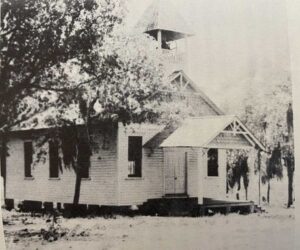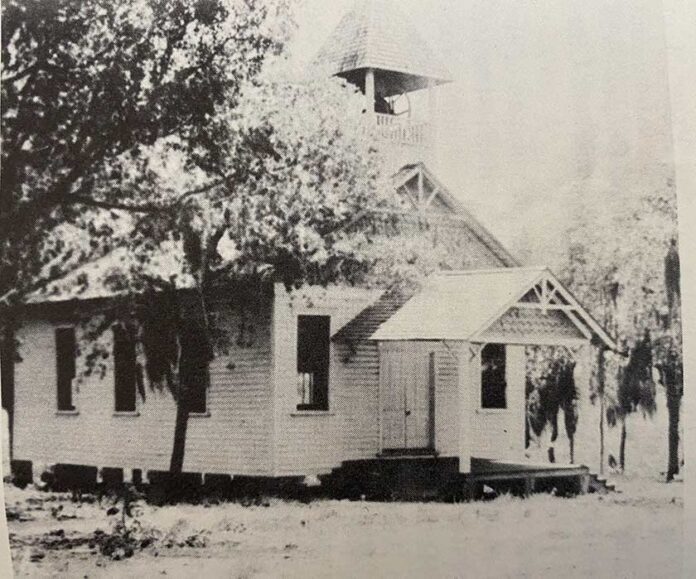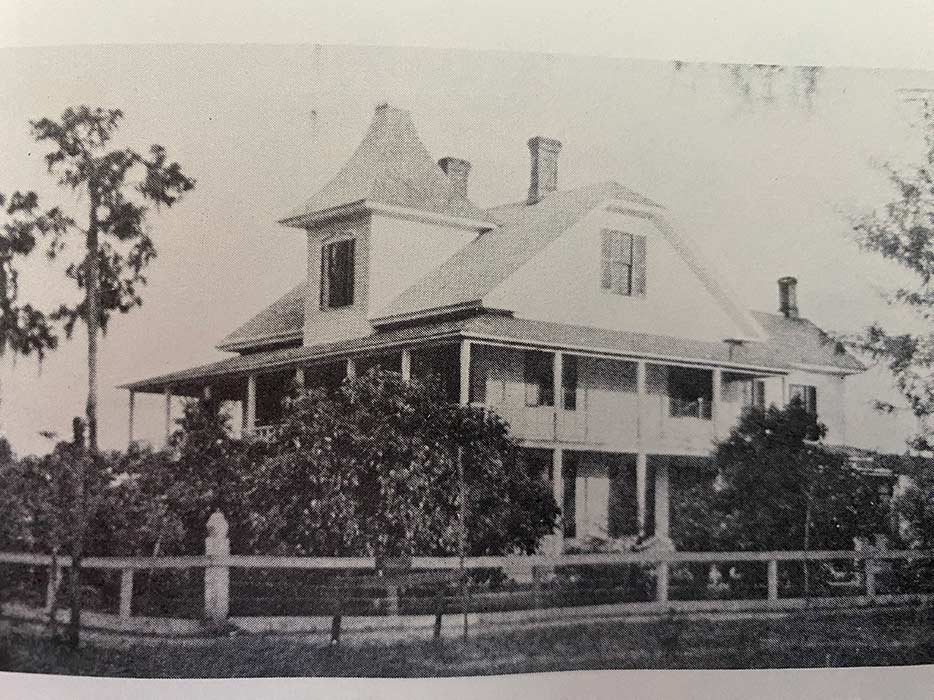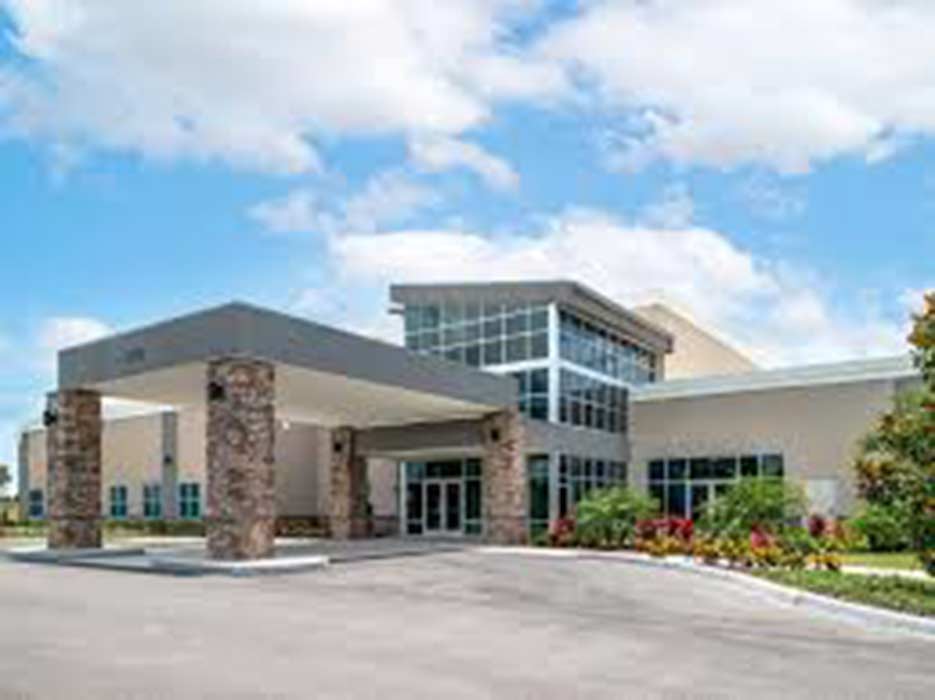by Chuck Seaver, South Lake Tablet
The corners of Montrose Street and 5th Street in Clermont have a unique and interesting past that dates back to the early days of a town that was first incorporated in 1884. Early settlers were still locating to this tiny town that was rich with fishing, hunting, farming, and hammocks of oak, hickory, and magnolia trees. Dirt roads throughout downtown remained a challenge to early navigators of oxcarts, horses, and simple foot traffic in the day-to-day life of Clermont’s early pioneers. This gem of the hills, nestled among the beautiful chain of lakes, would become home to many who had relocated from different areas, including the “bible belt” areas of the southern and midwestern states.
 In 1888, the Baptist Church, known as Grace Baptist, was organized with five members. A site on the southeast corner of Montrose and 5th Streets was selected by the membership for the congregation’s new church. The land was owned and donated to the church by M.E. Wilson, a prominent figure in the community. Wilson, a Philadelphia native, owned a general store on Montrose Street in the downtown area as well as a sawmill on the northwest shores of Lake Winona. Wilson also owned the property on the southeast corner of Minneola Avenue and 5th Street, where he built his family home that would eventually become the Gables Restaurant, owned by George and Ida Middlebrooks in 1944.
In 1888, the Baptist Church, known as Grace Baptist, was organized with five members. A site on the southeast corner of Montrose and 5th Streets was selected by the membership for the congregation’s new church. The land was owned and donated to the church by M.E. Wilson, a prominent figure in the community. Wilson, a Philadelphia native, owned a general store on Montrose Street in the downtown area as well as a sawmill on the northwest shores of Lake Winona. Wilson also owned the property on the southeast corner of Minneola Avenue and 5th Street, where he built his family home that would eventually become the Gables Restaurant, owned by George and Ida Middlebrooks in 1944.
By 1889, the wood frame church was completed at a cost of about $650.00, with a lot of the work being completed by community volunteers. The first pastor was D.B. Farmer. Services were usually held once or twice a month until 1915 when the church was reorganized, and a second pastor was added. Percy Seaver was named the first deacon of the church and was responsible for much of the restructuring, which included Sunday school classes for the youth of the community.
During the early 1900’s, the community was somewhat recovering from a devastating winter freeze that took place during the winter of 1894-95. Many of the original settlers left town for a variety of reasons, including no work. Merchants closed their shops due to the exorbitant amount of debt that local residents owed and had no way of paying. Considering the tough times, many people chose to stay and try again to rebuild their livelihoods and families. By 1923, the Grace Baptist family had grown to the point that a larger structure was needed to accommodate the growing congregation. The original church was moved to another location on the site with plans for a new church on the original location.
Along with the growth of the town came the growth of the church. The need for a permanent parsonage for the church became apparent if the church family wanted to secure a permanent minister for the church. Although the days of “circuit rider preachers” had passed, permanent dwellings for preachers remained a common practice dating back to the 12th century as a trend that began primarily in Europe, and the Baptist Church at this point had not followed suit.
Anthony Beach “Tony” McNiece and his wife May Bishop McNiece owned a beautiful, two-story, wood-framed home on the southwest corner of Montrose Street and 5th Street, across the street from the Baptist Church. McNiece purchased four lots to build the couple’s home after their 1891 marriage. Charles “C.O.” Roe, an early settler of Clermont, recalls in his 1941 autobiography that “Tony McNiece had the only house in town that had any paint on it. Perhaps others had, but it was hardly visible at that time.”
The McNiece family remained in the stately home until an agreement was made with the church to sell in 1936 when Tony died at the age of 68. The home remained occupied and maintained by the church for years. Preachers of the church, who resided in the parsonage, simply walked across 5th Street for church activities and were within walking distance of the nearby business district of downtown Montrose Street. The downtown district contained most of the common needs back then that including general stores, clothing and feed stores as well as eateries. Unfortunately, the home was engulfed with flame in 1943 and completely destroyed. All of the occupants escaped harm, and the origin of cause was never disclosed. Inadequate funds prevented the church from rebuilding the home and alternative provisions were made to accommodate the pastor and his family. Over the years, the vacant lot became a sand and grass parking area for the congregation and visitors.
It wasn’t until 1973 that the empty lot began a transformation that would lead to today’s paved parking area. Groundbreaking for a new Baptist Church sanctuary took place in November 1973. The church was designed by Nick Jones, a new architect in the community. The modern-day design of a steep-pitched roof and high ceilings shadowed the existing church and added additional seating for the congregation.
By 1973, a lot of things had changed both in the community and the building code requirements. The City of Clermont now had a full-time building and inspections department that included code requirements for new buildings and adequate parking for visitors. Traffic had increased substantially on both 5th and Montrose Streets from the early days even for a town that only had approximately 6,000 occupants at the time. Pedestrian traffic from the sand parking lot, with no crosswalks or sidewalks, to the church became an immediate concern. The church leaders and city officials worked together to create resolutions for the problems. Church leaders agreed to pave the parking lot and create two entry-exit ways: one on Montrose Street and one on 5th Street. The city agreed to improve the sidewalks and curbing to allow for friendly pedestrian access, including wheelchair access. The parking lot and improvements remain today.
The new church, located at 498 West Montrose Street, was dedicated during the morning service on September 22, 1974. The older church was utilized for various events and Sunday school rooms until it was razed several years later. The First Baptist Church organization remained in place until recently when the church was sold to the Florida Conference Association of Seventh-Day Adventists.
The First Baptist Church organization moved to a new campus at 2751 Hartwood Marsh Road, Clermont in 2020.
Downtown Clermont and the surrounding areas have a rich history that dates to the late 1800’s. Much of that history is recorded at the Clermont Historic Village Museum, including a replica, wood-framed chapel that resembles the Grace Baptist Church built in 1889. The Village is located at 490 West Avenue, Clermont. Visit the Village in person or virtually at www.ClermontHistoricVillage.org for hours, exhibits and historical information.












